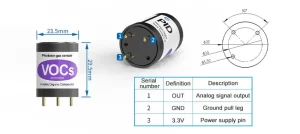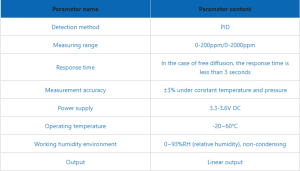In today's rapidly evolving world, innovation has become the driving force behind the success and growth of industries. One such innovation that is making a substantial impact across various sectors is gas sensors. Gas sensors have emerged as a critical technology, enabling businesses to monitor, analyze, and optimize their processes in unprecedented ways. In this article, we will explore the significant role gas sensors play in driving innovation, their applications across industries, and the future potential they hold.
Understanding Gas Sensors:
Gas sensors are electronic devices that detect and measure the presence of gases in the surrounding environment. They work by utilizing various detection principles such as electrochemical, semiconductor, thermal conductivity, and optical sensing. Each sensor type has its unique advantages and is designed to detect specific gases accurately. Gas sensors provide real-time data on gas concentrations, allowing businesses to make informed decisions to ensure safety, efficiency, and compliance.
Applications of Gas Sensors across Industries:
Gas sensors have found extensive applications across a wide range of industries. Let's dive into some key sectors where gas sensors are driving innovation:
- Environmental Monitoring: Gas sensors are widely used to monitor air quality and detect pollutants in the environment. They play a critical role in identifying harmful gases like carbon monoxide (CO), nitrogen dioxide (NO2), sulfur dioxide (SO2), and ozone (O3). By continuously monitoring the environment, gas sensors help governments, research institutes, and environmental agencies assess pollution levels, develop effective policies, and take necessary actions to improve air quality.
- Industrial Safety: In industrial settings, gas sensors are essential for ensuring worker safety. They detect hazardous gases and provide early warnings to prevent accidents and protect human lives. Gas sensors are deployed in industries dealing with volatile substances, such as oil and gas, chemical manufacturing, mining, and construction. By continuously monitoring gas levels, businesses can implement safety protocols, evacuate workers if necessary, and prevent potential disasters.
- Energy and Utilities: Gas sensors are extensively used in energy and utilities industries to monitor gas leaks, emissions, and process efficiency. In the oil and gas sector, gas sensors detect gas leaks, enabling prompt actions to mitigate risks and prevent environmental damage. In power plants, gas sensors monitor emissions like sulfur dioxide (SO2), nitrogen oxides (NOx), and carbon dioxide (CO2). By ensuring compliance with regulations, gas sensors help companies optimize energy production and reduce their environmental impact.
- Healthcare and Medical Applications: Gas sensors play a pivotal role in healthcare settings, from monitoring patient health to controlling the environment in hospitals. They are used to measure vital signs like oxygen levels, carbon dioxide levels, and anesthetic gases during surgeries. Gas sensors also help detect volatile organic compounds (VOCs) emitted from medical equipment or cleaning agents, ensuring a safe and healthy environment for patients and healthcare professionals.
- Agriculture and Food Industry: Gas sensors aid agricultural processes by monitoring gases related to plant health, greenhouse conditions, and post-harvest storage. They can detect gases such as ethylene, which is important for ripening fruits and vegetables, and ammonia, which can indicate poor sanitation in livestock facilities. By monitoring these gases, farmers can optimize their crop growth, reduce spoilage, and maintain food quality and safety.
- Automotive and Transportation: Gas sensors are crucial in the automotive industry, particularly in vehicles powered by natural gas or hydrogen fuel cells. They detect leaks, optimize fuel efficiency, and ensure the safety of passengers. Gas sensors are also used in vehicle exhaust systems to monitor emission levels, helping automotive manufacturers comply with stringent environmental regulations.
The Future Potential of Gas Sensors in Driving Innovation:
As technology continues to advance, gas sensors hold immense potential for driving further innovation across industries. Here are some future developments we can expect:
- Miniaturization and Integration: Gas sensors are becoming more compact, efficient, and cost-effective. With advancements in microfabrication techniques, sensors can be integrated into smaller devices, making them suitable for portable and wearable applications. Miniaturized gas sensors enable personalized monitoring of air quality, leading to enhanced safety and well-being.
- Internet of Things (IoT) Integration: Gas sensors will increasingly be integrated into IoT systems, creating a network of interconnected devices that can collect, analyze, and act upon data in real-time. This integration enables seamless monitoring and control of gas levels, leading to improved safety, energy efficiency, and predictive maintenance across industries.
- Artificial Intelligence (AI) and Machine Learning: The combination of gas sensors with AI and machine learning algorithms allows for advanced data analysis and pattern recognition. By leveraging AI capabilities, gas sensors can provide actionable insights, predict trends, and optimize processes automatically. This integration will enhance efficiency, reduce costs, and improve decision-making across various applications.
- Gas Sensing Arrays: Gas sensing arrays consist of multiple gas sensors with different selectivities, allowing for comprehensive gas analysis. These arrays can identify complex gas mixtures and specific gas patterns related to various applications. Gas sensing arrays hold great promise in industries such as medical diagnostics, where they can detect specific gases associated with diseases or infections.
Conclusion:
Gas sensors have emerged as a transformative technology, driving innovation across industries. Their ability to detect and measure gases accurately has revolutionized processes, improved safety, enhanced efficiency, and reduced environmental impact. From environmental monitoring to industrial safety, energy, healthcare, agriculture, and automotive sectors, gas sensors are playing a vital role in shaping the future.
As technology continues to advance, gas sensors will become even more crucial in driving further innovation. With miniaturization, integration with IoT and AI, and the development of gas sensing arrays, the potential applications for gas sensors will continue to expand. This opens up exciting possibilities for businesses and industries to leverage gas sensors in creating safer, more sustainable, and efficient processes.
As we move forward, the continuous development and adoption of gas sensors will undoubtedly breathe new life into industries, ensuring a brighter and more innovative future for all.
 : +86 155 8830 2704
: +86 155 8830 2704 : jxdziot@gmail.com
: jxdziot@gmail.com
